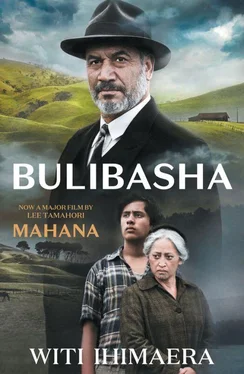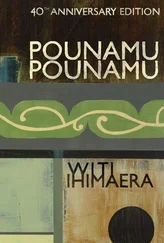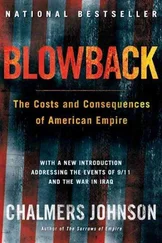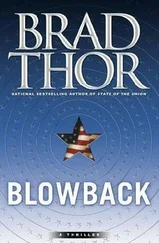Haromi was the first to notice Geordie’s visits. I think she was jealous because Geordie took me away from her. Not that we had been able to get together much ourselves, even after she was assigned to Mahana Four: the protocol during shearing was that the women and the girls kept together and the men and boys did the same.
‘There’s your kehua friend,’ she said.
‘He’s a kehua,’ I agreed, ‘but he’s okay. He likes books too.’
Haromi could be mean and vicious sometimes.
‘Oh, another brainbox,’ she answered, ‘and a sissy too.’
I suppressed my anger. In those days you could be a sissy just by liking a picture by a famous artist or classical music or ballet dancing. A sissy was somebody like Freddie Murphy, the boy at school who was in Miss Mallard’s tap dancing class along with Rona Clare and Jane Taylor. He was like William Haskins who was excused playing sport to protect his fingers for the pianoforte and, as he used to explain, after being ragged ‘playing the workth of Franth Litht’. Instead of being admired for the courage of daring to be different, a sissy was ridiculed.
There was another criticism too, just as implicit and just as ambiguous.
‘I see you’ve made friends with Geordie,’ my father said to me later.
‘Maybe,’ I said.
Dad nodded. Then, ‘He’s the boss’s son.’
‘Yes, I know that.’
‘Good. As long as you remember it.’
I crimsoned. Then I got really angry. Something unfair was going on. My friendship with Geordie — if that’s what it was — hadn’t even got off the ground and it was being ambushed by innuendo and assumption. The usual notions of the forbidding rural God, all of the ‘Thou shalt nots’ which dictated relationships, were being applied. Did I even care if Geordie was a sissy? That by associating with him, that I was one too? And so what if he was the boss’s son! That was the criticism that hurt most. My own father was telling me, just as Grandfather had told me, that I had my place and I should stay in it. Mine the dusty road, Geordie’s the tar seal.
To Hell with the lot of them.
A shearing gang working at the height of summer, nine hours a day, six days a week, is like nothing else on earth. I suppose if my sisters and I had known any better, we would have grown to dislike the sheer slog, sweat and boredom of repetitive work. However, because we were born to it, shearing was simply something we did in summer. At a time when other Maori families were fragmenting, the shearing kept the Mahana clan together. It replicated the dynamics of an iwi. As long as it survived, we needed no other support system.
A day of shearing started at five in the morning and finished at five in the evening. We had an hour off for breakfast at seven, half an hour for smoko at nine forty-five, an hour for lunch at noon and another half hour for smoko at two forty-five. The three main meals were eaten at the cookhouse; smoko was delivered to us by Aunt Esther, Faith, Hope and Willie — hot cocoa, tea for the non-Mormons, sausages, eggs, fried bread, and scones with lashings of butter and golden syrup. Sometimes, after afternoon smoko, Aunt Esther would stay at the shed to help the fleecos.
Our lives were driven by the phut — phut — fart of the engine, the whine of the driveshaft and the loud buzzing of the handpieces. Aunt Ruth, listening one day, said, ‘No wonder I hate Mum’s bees!’ Doors slammed as the shearers went into the pens, and the press clanked as David and Benjamin pressed the wool. People shouted all the time. In the background was the constant bleating of sheep and barking of dogs, and whistles as the shepherds moved sheep in the yards.
The shearer was king. It was up to Uncle Hone on the Number 1 stand to maintain a good steady pace so that by the end of day all the shearers had made near enough to the magic tally of three hundred on full wool ewes. Dad, on the Number 2 stand, had a role too — gently pushing Uncle Hone along by being just behind him. Shearing gangs valued a good pacemaker like Uncle Hone. From him came the rhythm which would enable the entire gang to get through the season. Better that than somebody who pushed the pace and burnt out his gang. Uncle Matiu was like that — no wonder, as Mahana One was regarded as top gang and Uncle Matiu had to be king of kings. Having Grandfather driving him couldn’t have made it any easier. Shearers, of course, didn’t always make their daily three hundred. Sometimes a board placing was purposely kept open for a new shearer. He too was important in setting the pace — the bottom marker by whom the median could be found. Mahana Four didn’t have a new boy this season, but David and Benjamin were raring to have a go.
Older shearers liked having a new boy on the board. They helped with advice on how to hold the sheep in the right way. Or how to apply a better technique to your shearing. Or when to take broad sweeping cuts. Or how to conserve your energy. Shearing was not normally a race, and the ‘guns’ among the shearers were those respected for their fluid style and ability to shear without cutting or marking a sheep. Such shearers also happened to be fast .
It was always good to watch a gun shearer. That was how every Mahana boy learned his craft. I learned by watching my Dad. He came dragging a sheep out of its pen and propped it between his legs in such a way that it couldn’t move. He’d pull on the cord to start the handpiece and he was away.
First, two strokes on the top of the head, then the shoulders and into the long blow up the back of the sheep. Haromi came to sweep the wool away into its own separate pile on the board. Short strokes on the throat and insides of the legs, and longer strokes down and around the tits or ure (be careful!) to the rump. Next, Dad bent and shore down the right of the sheep. Again, Haromi with deft movements swept this grade wool away into a separate pile; the dags were swept Glory’s way, and she salvaged any wool by picking through the dags. Best not to have long fingernails for that job.
Then came the part I liked best — the shearing of the fleece itself. It came off the sheep in one piece like a golden coat. Dad changed the sheep’s position so that it was lying with its left side facing up. He began the long curving boomerang blows along the right flank, stroke after stroke, driving the handpiece through the wool, the fleece peeling magically away. Sometimes, though, the slightest movement of the sheep would cause the dumb thing to be cut by accident.
‘Tar!’ The cut needed to be sealed.
Dad then moved into the sheep to prop it on its bum again and began the short horizontal strokes on the right side. At every stroke the fleece fell away. Both shearer and sheep were encircled by the fabulous golden sheep. Aunt Ruth was there by then, to pick up the fleece and –
‘Baaa!’ With an outraged kick the sheep was pushed out from under Dad to slide ignominiously down the shute into its outside pen.
Easy, eh! Now you try it!
I have to admit that although Dad was probably faster, Uncle Hone was the best shearer in Mahana Four. I loved watching his style. People didn’t normally equate shearing with style: I guess that commodity was more acceptable on the modelling catwalk where the wool was displayed in its finished designer packaging. There was, however, an art to shearing just as there was to most work, and Uncle Hone was a Botticelli of the board. Once I asked him what his secret was.
‘You really want to know?’ he asked. His eyes were twinkling. ‘Well, it’s not the actual shearing of the sheep which is the secret but, rather, the relationship you make with the sheep.’
Huh?
‘A sheep,’ he continued, ‘isn’t going to like it if you charge right into your pen and wrestle it and throw it to the ground, is it?’
Читать дальше












